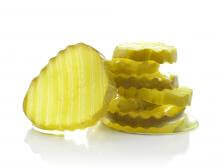Are Pickles Good for You?
Are pickled vegetables a good alternative to fresh vegetables or are they bad for you?
Keith writes with a question about pickles and whether they are good for you and can be a good source of nutrition.
Are Pickles Good for You?
Pickling is a time-honored way of preserving foods for an extended period of time without refrigeration. Traditionally, it was used to ensure a food supply during times when fresh food would be unavailable, such as over the winter or on a long voyage. You can pickle just about anything: fruits, vegetables, even meat and fish.
What Are the Benefits of Pickling Foods?
In a nutshell, the idea of pickling is to create an environment that is inhospitable to the microbes and enzymes that would normally cause food to decay—as well to prevent the growth of micro-organisms that could make you sick. This is usually done using a combination of salt, acid, and/or fermentation with friendly lactobacillus bacteria. Spices, oil, or sugar can also be added to enhance the flavor.
What are the Health Benefits of Vinegar?
In traditionally fermented pickles, the sour taste is the result of natural acids that are produced by the bacteria during fermentation. Other methods skip the fermentation and use vinegar instead. Vinegar has some unique benefits of its own.
The claim that vinegar helps you burn fat is true, but only on a technicality. The acetic acid in vinegar can increase your fat-burning metabolism. But, as I discussed in a previous article, this effect is so small that it is unlikely to translate into any noticeable fat loss. However, adding vinegar to a meal can have a noticeable effect on your blood sugar levels. The acids in vinegar slow the digestion and absorption of carbohydrates, which is generally a good thing.
See Also: Does Vinegar Burn Fat?
How Are Modern Pickles Made?
In the days of modern food processing, of course, we have other ways of keeping food from spoiling, such as refrigeration and pasteurization. Indeed, most of the pickles sold these days in grocery stores actually rely on pasteurization and/or refrigeration to preserve the food. Salt and vinegar are still used, but mostly for flavor.
Are Pickles Nutritious?
As for how nutritious pickles are, it depends on what you’re pickling and the method you use. Keith, who lives in Japan, is in luck. Traditional Asian pickles are probably the most nutritious kind of pickle. First of all, they start with cabbage, radishes, peppers, and other super-nutritious vegetables. The raw veggies are then packed with salt or a brining solution and allowed to ferment at room temperature. Fresh sauerkraut, native to Germany and Eastern Europe, is another example of a traditionally fermented vegetable.
No heat is involved in the production of traditionally fermented pickles and that helps preserve the nutrients in the vegetables. In fact, the fermentation process actually adds valuable nutrients. The lactobacillus bacteria that cause the fermentation produce B vitamins and also act as probiotics that help keep your digestive tract healthy.
See Also: Benefits of Fermented Foods
Pickles and Salt
The only potential downside to traditionally fermented pickles is the salt content. Again, the salt is key to promoting fermentation and suppressing harmful bacteria. If you’re trying to limit your sodium intake, you’d want to keep that in mind. Other than that, however, traditional fermented pickles are a nutritious alternative to fresh vegetables.
See Also: Sodium High
Do Pickles Count as a Vegetable?
The sweet cucumber pickles you typically encounter here in the U.S., on the other hand, are probably among the least nutritious type of pickles. Cucumbers aren’t terribly nutritious vegetables to begin with. Boiling them in sugar syrup, packing them in jars, and then heat-treating the jars to pasteurize them doesn’t exactly improve their nutritional profile. In fact, given the sugar, the salt, and the lack of any meaningful nutritional value, I’d be reluctant to let you count sweet pickles as one of your servings of vegetables. Dill pickles wouldn’t be high in nutrition, either, but at least would be lower in sugar.
See also: Why is Sugar Bad?
Pickled carrots, cauliflower, green beans, or combinations of pickled vegetables—sometimes called chow chow or giardiniera—would fall somewhere in between traditionally fermented pickles like Kim-chi or sauerkraut and the standard American bread-and-butter pickle.
One the one hand, they are usually heat-processed, which involves some nutrient losses, and you wouldn’t get the benefits of probiotic bacteria. On the other hand, they’re made from nutritious vegetables and usually without as much added sugar. I’d count them as a serving of vegetables. But again, you’d want to be mindful of the sodium.
See Also: How to Get More Vegetables into Your Diet and How Cooking Affects Nutritients
How to Make Your Own Pickles
Lately, there’s been a revival of interest in the traditional arts of pickling, canning, and fermenting. If you’re interested in learning more about how to make your own pickles, I’ve included some links below to resources for you to explore.
Keep in Touch
If you have a suggestion for a future show topic or would like to find out about having me speak at your conference or event, send an email to nutrition@quickanddirtytips.comcreate new email
You can also post comments and questions on my Nutrition Diva Facebook Page. I answer a lot of listener questions in my free weekly newsletter, so if you’ve sent a question my way, be sure you’re signed up to receive that.
Have a great week and remember to eat something good for me!
RESOURCES:
Preparing Fermented and Pickled Foods (National Center for Home Food Preservation)
Fermented Vegetables (Herb Companion)
Preserving Sauerkraut (Penn State)
Japanese Tsukemono Pickles (Just Hungry)
How to Make Kimchi (Dr. Ben Kim)
Pickles image from Shutterstock



